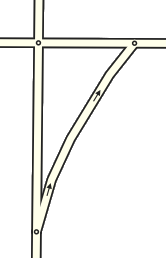
|
Estamos trabajando en esta página, por lo que pueden haber enlaces perdidos. Gracias por vuestra paciencia ;)
|
| Mantente a la derecha | Mantente a la izquierda |
| Gira a la derecha | Gira a la izquierda |
| Sal a la derecha | Cambia de sentido |
Antes de continuar asegúrate que entiendes el funcionamiento de las restricciones de giro. En caso de que no estén bien definidas las rutas proporcionadas por Waze serán erróneas. Aquí se proporciona un resumen sobre cómo se fijan las instrucciones de navegación controlando los ángulos de las intersecciones. La información detallada de la forma en la que Waze determina la instrucción en una navegación se puede encontrar en el artículo Cómo determina Waze las maniobras.
Geometría
Todas las intersecciones deberían seguir unos ángulos de salida determinados. En la siguiente tabla se muestra los rangos de ángulo para cada instrucción:
| Ángulo de salida | Instrucción de navegación |
|---|---|
| 0°-45° | Mantente a la izquierda o a la derecha o Sal a la derecha |
| 45° - 170° | Gira a la izquierda o a la derecha |
| 170° - 180° | Cambia de sentido |
El ángulo de salida es el ángulo relativo de la desviación con respecto a continuar recto, en grados. Similar al cambio de rumbo de un barco o un avión.
Es mejor que los ángulos de salida no se encuentren en la zona de cambio de instrucción, pues en esos ángulos pequeños cambios de geometría pueden cambiar la instrucción. Es mejor forzar ángulos de 20° o de 90° para alejarnos de estos ángulos de cambio de instrucción. Es difícil porque habitualmente colocamos los segmentos con ángulo de 45°. Para ayudarnos existen scripts como Jucntion Angle Info, que marca los ángulos de salida, alerta cuando el ángulo está en la zona de cambio y predice la instrucción que proporcionará el navegador.
Stay away from the ends of the ranges (44°) as those are tipping points between the settings that are hard to determine visually on the map. Instead stick with the centerpoints (22°, 90°) shown in the departure angles column for better predictability.
NOTE:
- There are exceptions to these rules covered in the section Segment name and type below.

- Avoid having the angle between any two diverging segments be less 10°, this makes it very difficult to select the turn arrows in WME, as well as in the client 'Report>Road Closure'. Make the departure angle at the junction closer to 10°-20°. See the section on diverging roads, and Ramp geometry for more details.
- Turn instruction override can be used to control the turn instruction in cases where a (more or less) true-to-life angle will not give the appropriate instruction.
Examples

|
For road splits at a Y or at-grade connectors, it is important to identify which road is "straight" and which bears off to the side. It is not good to have one at zero degrees and the other branch at 5 degrees. Instead show the branch at 30 degrees to be sure the Keep Right (or Left) instruction is given. For this case, adjust the geometry node of the branching road near the junction to control that angle.
In these two examples of at-grade connectors, if the departure angle is set for 30 degrees, a "Keep Right" instruction is provided to follow the curved one-way connector. But if a "Turn Right" instruction is appropriate, simply use a Turn instruction override.
Segment name and type
In addition to the geometry of the road segments, the road names and types of the attached segments affect the routing algorithms as well.
Name
Generally, differences in road names at junctions will improve the chances (but not guarantee) that it will happen. In the case of the at-grade connector example above, the connector should either have a different name than the road it is leaving, or no name at all. See the road name section of the at-grade connector article.
Type
Although road type is a factor in determining navigation instructions, road names and angles are much more important. If multiple roads meet at a junction and one segment transitions to another at close to zero degrees and they both have the same name, that direction is considered straight no matter what road types are used. An example demonstrating this is shown in the discussion on Y-intersections in the Junction Style Guide.
| Plantilla:NeedImage |
Road type will be the determining factor when all names are different. For example, a Ramp segment leads to a Freeway segment and another Ramp segment. The Ramp segment will be considered the "straight" continuation and there will be no announcement while a navigation instruction will be given to proceed to the Freeway segment. This is true even if the initial Ramp and the Freeway align at close to 0 degrees and the second Ramp departs at a 20 to 30 degree angle.